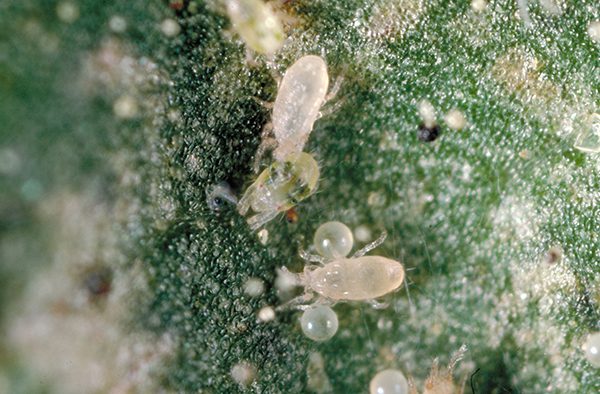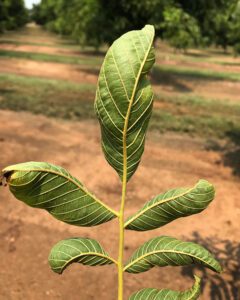
Extremely hot weather in July and more heat in August increased water stress and spurred pest mite populations in many almond and walnut orchards over the summer, causing an increase in premature defoliation in some orchards. As growers enter a new season, those pressures should serve as a reminder for growers to keep web-spinning mites in check.
Sudan Gyawaly, a UCCE area integrated pest management advisor in Butte, Glen, Tehama, Colusa and Sutter-Yuba Counties, said web-spinning spider mites gained a foothold in orchards this year, causing widespread infestations. Severe defoliation in walnuts can result in sunburn nuts and loss or quality. Premature and severe defoliation of almond and walnut trees can have a negative effect on next year’s crop yields and reduce vegetative growth.
Franz Niederholzer, UCCE orchard systems advisor in Colusa, Sutter and Yuba counties, said the heat wave in July plus more heat in August produced water stress, increasing pest mite populations in many almond and walnut orchards in the region. Disease and/or water stress can also cause trees to prematurely drop leaves, but he said poor orchard economics may have influenced mite control decisions, with some growers delaying or perhaps skipping mite control. In addition, aggressive navel orangeworm control programs in almond orchards may have reduced beneficial insect and mite numbers, contributing to the increased spider mite pressures this year.
Treatment decisions should be based on thresholds of numbers of mites and their predators. Cultural controls, including oil or water on roadways and planting ground cover can reduce dust which contributes to mite infestations. Just treating hot spots is another option. Selecting insecticides and/or miticides with limited to no impact on beneficials is also an important step in spider mite integrated pest management. See ipm.ucanr.edu/agriculture/ for comparison of impacts of different pesticides on non-pest insects and mites.
Female Mites Overwinter as Adults
Several species of web-spinning mites can cause tree defoliation as they suck cell contents from leaves. Gyawaly said among several mites species occurring in orchards, Pacific spider mites and Two-spotted spider mites, two web-spinning spider mites, are the main destructive species in almond and walnut. For these species, females overwinter as adults under tree bark, in ground litter or on winter weeds.
In spring, the overwintering females begin feeding on leaves. Colonies develop on the underside of leaves and move to the upper sides as populations build. Overwintering Pacific and two-spotted mite females are reddish-orange. In-season, the adult mites are usually yellow to green in color. Eggs are spherical and translucent at first then become opaque. Immature mites molt three times before becoming adults. In the first stage, mites have six legs and later stages and adults have eight legs. Niederholzer said mites will reproduce rapidly in hot weather and without control (biological or chemical), and populations can flare in June and July. With optimal temperatures and a food supply, a generation can be produced in seven days.
Clusters of brown leaves are the first sign of building mite infestations in an orchard. High numbers of mites produce visible webbing.
Monitoring orchards for pest mite populations should begin in March, Gyawaly said. Scouting every two weeks from March to early May, particularly if mite pressure was high the previous year, and once a week after that is advised. Scouting involves not only inspecting leaves for pest mites but also for predators which can keep pest mites under control.
Spider mite predators in orchards, including western predatory mite, six-spotted thrips and spider mite destroyer, are all biological controls, but their numbers may not build until spider mite numbers are high. Use of broad-spectrum insecticides (especially pyrethroids) at a critical time of predatory mite population growth will impact this biological control.

Common Predators
According to UC IPM guidelines, six-spotted thrips are the most common predator of spider mites. Six-spotted thrips are very mobile and both nymphs and adults feed on spider mites. Adults are about 1/8-inch (3 mm) long and pale yellow to whitish. Adults have long, hairlike fringes on the margins of their wings. At rest, three dark spots are apparent on each whitish forewing; these six dark wing spots on a pale yellow to whitish thrips distinguishes this species from other thrips. Six-spotted thrips larva is translucent white to yellowish.
Western predatory mite can be distinguished from pest mites by the color difference and its lack of the dark blotches. It also takes on the color of its prey after feeding on reddish colored spider mites. It is also smaller than other predator mites.
Predator mites are also shaped differently than pest mites as spider mites are broader in the front compared to predatory mites that are broader at the rear and more active.
The spider mite destroyer is actually a beetle. The adults are black and about 1/16-inch (1.5 mm) long. They may appear greyish due to presence of tiny, pale hairs. Destroyer eggs are oval, about 1/64-inch (0.4 mm) long. They are pale yellow to white when laid then turn gray and become black before hatching.
The larva is oblong and dark brown to gray when young. It is covered with numerous, minute, branched hairs. As the larva matures, it becomes reddish, at first on the edges of the body; just prior to pupation, the entire larva turns reddish.
Pupae are oblong or oval when viewed from above and flattened when viewed from the side. They are covered with tiny, pale hairs and, depending on maturity, vary in color from black to brown, gray or reddish.
Spider mite destroyers feed on all stages of spider mites. Adults and larvae can each consume 75 mites per day. Adults fly and more where mites are abundant.
Sampling Can Determine Infestation Levels
Sampling leaves will help determine extent of spider mite infestation and presence of predators.
The protocol outlined in the UC IPM Guidelines said the within each sampling area, from a minimum of five trees, select 15 leaves from both the inside and outside of the canopy. Both sides of each leaf should be examined for spider mites and eggs, Western predatory mites and eggs, six-spotted thrips and other predators. The number of leaves with pest mites or eggs and the number of leaves with predators should be counted.
Using a hand lens, look for mite activity on the top and underside of leaves, noting presence or absence of spider mites and predators, Gyawaly advised. Recommended guidelines are as follows:
• If no predators are present, treatments should be made if about 30% of leaves have spider mites on them.
• If predators are present, treatments can be held off until about 50% of the leaves are infested.
• 5 trees, 75 leaves, no treat if ≤27, treat ≥40, continue sampling in between (in presence of predator)
• 5 trees, 75 leaves, no treat if ≤12, treat if ≥24, continue sampling in between (in absence of predators)
As the new season develops a disciplined sampling protocol can keep spider mite infestations at bay for 2025.

Cecilia Parsons | Associate Editor
Cecilia Parsons has lived in the Central Valley community of Ducor since 1976, covering agriculture for numerous agricultural publications over the years. She has found and nurtured many wonderful and helpful contacts in the ag community, including the UCCE advisors, allowing for news coverage that focuses on the basics of food production.
She is always on the search for new ag topics that can help growers and processors in the San Joaquin Valley improve their bottom line.
In her free time, Cecilia rides her horse, Holly in ranch versatility shows and raises registered Shetland sheep which she exhibits at county and state fairs during the summer.















